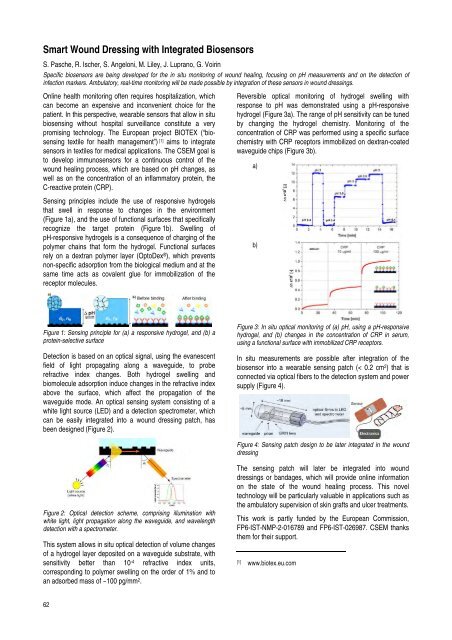research activities in 2007 - CSEM
research activities in 2007 - CSEM
research activities in 2007 - CSEM
You also want an ePaper? Increase the reach of your titles
YUMPU automatically turns print PDFs into web optimized ePapers that Google loves.
Smart Wound Dress<strong>in</strong>g with Integrated Biosensors<br />
S. Pasche, R. Ischer, S. Angeloni, M. Liley, J. Luprano, G. Voir<strong>in</strong><br />
Specific biosensors are be<strong>in</strong>g developed for the <strong>in</strong> situ monitor<strong>in</strong>g of wound heal<strong>in</strong>g, focus<strong>in</strong>g on pH measurements and on the detection of<br />
<strong>in</strong>fection markers. Ambulatory, real-time monitor<strong>in</strong>g will be made possible by <strong>in</strong>tegration of these sensors <strong>in</strong> wound dress<strong>in</strong>gs.<br />
Onl<strong>in</strong>e health monitor<strong>in</strong>g often requires hospitalization, which<br />
can become an expensive and <strong>in</strong>convenient choice for the<br />
patient. In this perspective, wearable sensors that allow <strong>in</strong> situ<br />
biosens<strong>in</strong>g without hospital surveillance constitute a very<br />
promis<strong>in</strong>g technology. The European project BIOTEX (“biosens<strong>in</strong>g<br />
textile for health management”) [1] aims to <strong>in</strong>tegrate<br />
sensors <strong>in</strong> textiles for medical applications. The <strong>CSEM</strong> goal is<br />
to develop immunosensors for a cont<strong>in</strong>uous control of the<br />
wound heal<strong>in</strong>g process, which are based on pH changes, as<br />
well as on the concentration of an <strong>in</strong>flammatory prote<strong>in</strong>, the<br />
C-reactive prote<strong>in</strong> (CRP).<br />
Sens<strong>in</strong>g pr<strong>in</strong>ciples <strong>in</strong>clude the use of responsive hydrogels<br />
that swell <strong>in</strong> response to changes <strong>in</strong> the environment<br />
(Figure 1a), and the use of functional surfaces that specifically<br />
recognize the target prote<strong>in</strong> (Figure 1b). Swell<strong>in</strong>g of<br />
pH-responsive hydrogels is a consequence of charg<strong>in</strong>g of the<br />
polymer cha<strong>in</strong>s that form the hydrogel. Functional surfaces<br />
rely on a dextran polymer layer (OptoDex ® ), which prevents<br />
non-specific adsorption from the biological medium and at the<br />
same time acts as covalent glue for immobilization of the<br />
receptor molecules.<br />
Figure 1: Sens<strong>in</strong>g pr<strong>in</strong>ciple for (a) a responsive hydrogel, and (b) a<br />
prote<strong>in</strong>-selective surface<br />
Detection is based on an optical signal, us<strong>in</strong>g the evanescent<br />
field of light propagat<strong>in</strong>g along a waveguide, to probe<br />
refractive <strong>in</strong>dex changes. Both hydrogel swell<strong>in</strong>g and<br />
biomolecule adsorption <strong>in</strong>duce changes <strong>in</strong> the refractive <strong>in</strong>dex<br />
above the surface, which affect the propagation of the<br />
waveguide mode. An optical sens<strong>in</strong>g system consist<strong>in</strong>g of a<br />
white light source (LED) and a detection spectrometer, which<br />
can be easily <strong>in</strong>tegrated <strong>in</strong>to a wound dress<strong>in</strong>g patch, has<br />
been designed (Figure 2).<br />
Figure 2: Optical detection scheme, compris<strong>in</strong>g illum<strong>in</strong>ation with<br />
white light, light propagation along the waveguide, and wavelength<br />
detection with a spectrometer.<br />
This system allows <strong>in</strong> situ optical detection of volume changes<br />
of a hydrogel layer deposited on a waveguide substrate, with<br />
sensitivity better than 10 -4 refractive <strong>in</strong>dex units,<br />
correspond<strong>in</strong>g to polymer swell<strong>in</strong>g on the order of 1% and to<br />
an adsorbed mass of ~100 pg/mm 2 .<br />
62<br />
Reversible optical monitor<strong>in</strong>g of hydrogel swell<strong>in</strong>g with<br />
response to pH was demonstrated us<strong>in</strong>g a pH-responsive<br />
hydrogel (Figure 3a). The range of pH sensitivity can be tuned<br />
by chang<strong>in</strong>g the hydrogel chemistry. Monitor<strong>in</strong>g of the<br />
concentration of CRP was performed us<strong>in</strong>g a specific surface<br />
chemistry with CRP receptors immobilized on dextran-coated<br />
waveguide chips (Figure 3b).<br />
a)<br />
b)<br />
Figure 3: In situ optical monitor<strong>in</strong>g of (a) pH, us<strong>in</strong>g a pH-responsive<br />
hydrogel, and (b) changes <strong>in</strong> the concentration of CRP <strong>in</strong> serum,<br />
us<strong>in</strong>g a functional surface with immobilized CRP receptors.<br />
In situ measurements are possible after <strong>in</strong>tegration of the<br />
biosensor <strong>in</strong>to a wearable sens<strong>in</strong>g patch (< 0.2 cm 2 ) that is<br />
connected via optical fibers to the detection system and power<br />
supply (Figure 4).<br />
Figure 4: Sens<strong>in</strong>g patch design to be later <strong>in</strong>tegrated <strong>in</strong> the wound<br />
dress<strong>in</strong>g<br />
The sens<strong>in</strong>g patch will later be <strong>in</strong>tegrated <strong>in</strong>to wound<br />
dress<strong>in</strong>gs or bandages, which will provide onl<strong>in</strong>e <strong>in</strong>formation<br />
on the state of the wound heal<strong>in</strong>g process. This novel<br />
technology will be particularly valuable <strong>in</strong> applications such as<br />
the ambulatory supervision of sk<strong>in</strong> grafts and ulcer treatments.<br />
This work is partly funded by the European Commission,<br />
FP6-IST-NMP-2-016789 and FP6-IST-026987. <strong>CSEM</strong> thanks<br />
them for their support.<br />
[1] www.biotex.eu.com








